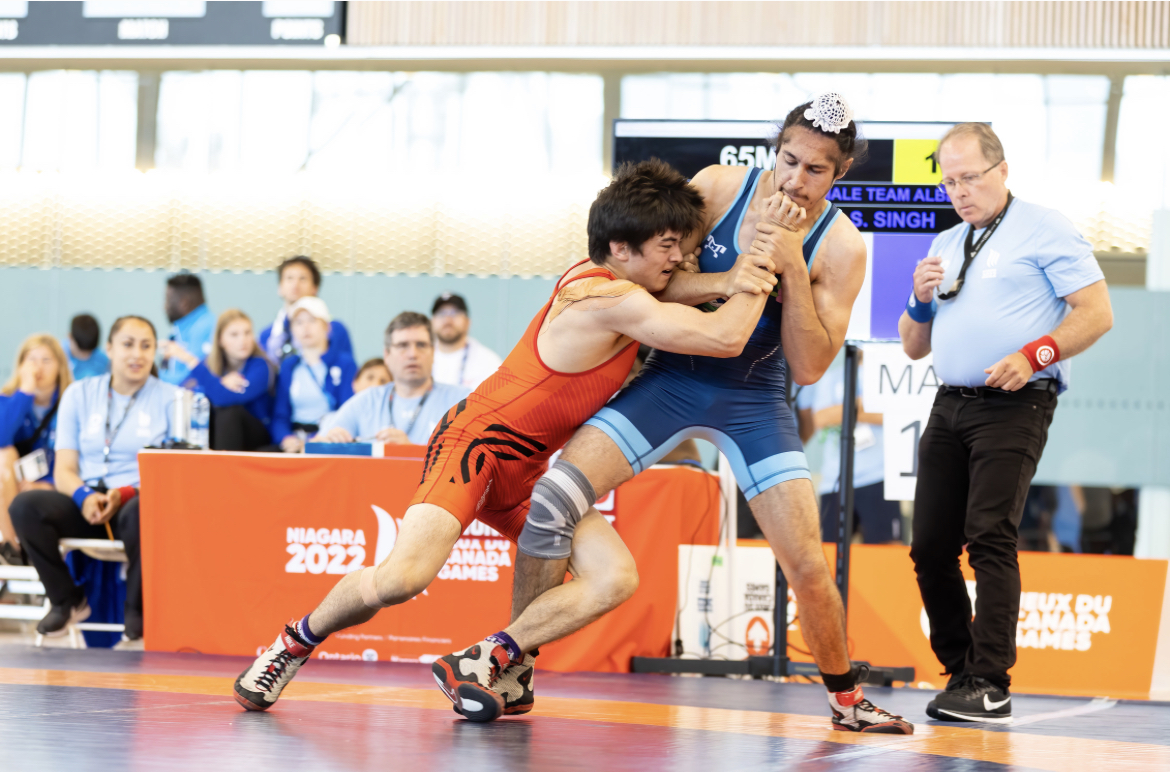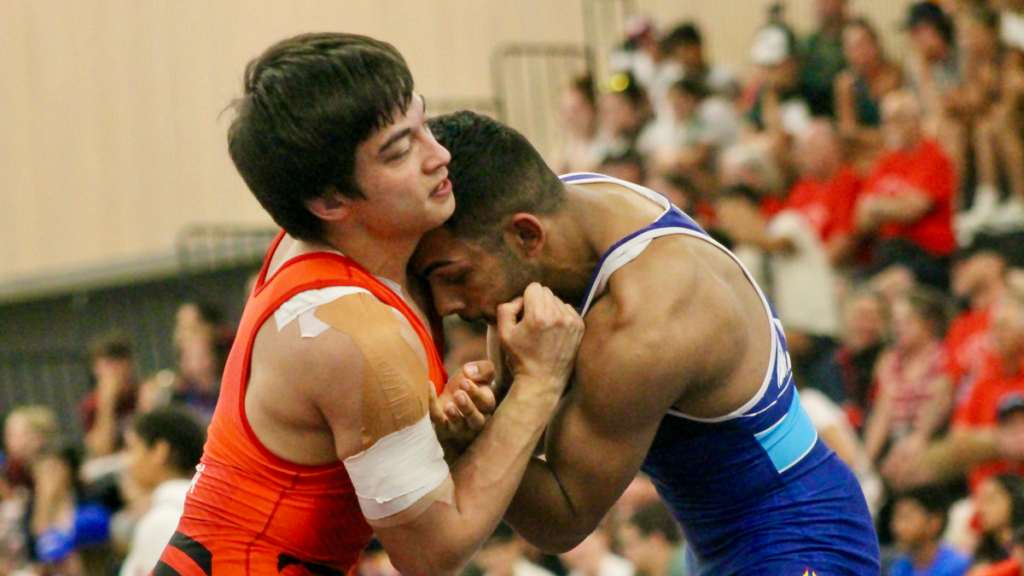Balancing Act: Navigating weight cutting in sports for athlete well-being
March 27, 2024
Weight cutting in sport sounds harsh because it is. As a U19 national champion wrestler with international experience and a mixed martial artist, I have first-hand experience losing weight in a short amount of time to compete in my desired category. And I can tell you that it is both mentally and physically daunting.
My most vivid memory of weight cutting took place at a tournament in August of 2022, I had to shed 6 kilograms fast to compete in the 65-kilogram freestyle wrestling category. In order to do this, I had to maintain about 300 calories a day, only being fueled by the caffeine and black coffee. Throughout this process, my coaches and my team did their best to support me through the struggle providing me with low calorie, but effective nutrients, and encouraging rest.
Looking around, I witnessed fellow athletes going through similar struggles with some even failing to make weight and consequently getting disqualified. To me, this only highlighted the intensity of the process.
While I was able to successfully achieve the target weight, this experience provided me with valuable insights into the potentially harmful aspects of weight cutting. This practice, which most frequently happens in sports with weight categories such as wrestling, boxing, and rowing, involves rapid and potentially drastic weight loss. It’s often achieved through shedding water weight within hours or days, with the aim of qualifying for a lower weight class. My own experience, coupled with what I witnessed, raised concerns about the impact on athletes’ overall well-being, prompting me to ponder the balance between weight cutting and safeguarding health.
To address some of my concerns and questions, I went to the experts in both academia and coaching to gain further insight into the issue.
Gaining a scientific perspective on weight cutting
Stuart Phillips, a professor and Tier 1 Canada Research Chair in Skeletal Muscle Health at McMaster University’s Department of Kinesiology, explained that the primary challenge athletes face during weight cutting is dehydration.
“And you know, the one thing that we do know that impairs athletic performance, probably quicker than anything else is to be dehydrated. So, you know, for a lot of athletes, it’s a really tough thing to do,” Phillips explained.
Studies on dehydrated Judo athletes revealed reduced grip strength and poorer judo-specific performance (Ceylan et al., 2022). Additionally, losing water weight leads to the burning of muscle-stored carbohydrates, which is an issue because those carbohydrates, stored as glycogen, serve as the preferred energy source for high-intensity activities. Each gram of glycogen corresponds to 2.7 grams of water (Lorenzo et al., 2019), resulting in their simultaneous loss during dehydration.
Preserving muscle mass is also a major concern for athletes undergoing weight reduction. To cut weight safely, Phillips along with contemporary researchers, recommends increasing protein intake while reducing energy-dense and nutrient-poor foods (Nunes et al., 2022).
Prioritizing nutrient-rich options like dairy, eggs, and plant or animal-based proteins helps maintain muscle while gradually reducing body fat. He emphasizes that individual body types vary, necessitating experimentation to meet an athlete’s specific needs. In my own experience, decreasing carb intake and replacing it with low calorie options such as lettuce along with increasing chicken and red meat consumption is effective in reducing body fat while maintaining muscle mass.
Weighing in on safe practices

To gain a comprehensive understanding of the ‘correct’ methods for weight management, it is vital to seek insights from dietitians closely involved with athletes practicing weight cutting.
Heather Hynes, a Sport Dietitian and Sport Nutrition Lead at the Sport Medicine & Science Council of Saskatchewan and with Wrestling Canada Lutte (WCL), has collaborated with numerous high-performance wrestlers, crafting plans for weight management and overseeing overall weight cuts.
Hynes emphasizes the importance of meticulous planning while engaging in weight management practices. Well-made plans should consider individualized factors such as metabolism, sweat rate, and ideally, be developed in collaboration with dietitians. Commencing these plans early, approximately 2 to 3 months before competition, ensures optimal results and safety. Notably, total energy intake isn’t the sole consideration; energy distribution, like increasing carb intake during training and decreasing during rest, plays a crucial role.
Beyond creating a plan, Hynes highlights the importance of reviewing meal plans and strategies throughout the process with coaches and dietitians when available, while acknowledging that modifications or deviations are likely. Maintaining a close record of consumption helps athletes effectively refuel.
It’s crucial to recognize that weight management and cutting should respect the physical maturation of youth athletes. Hynes advises against athletes staying in the same weight class throughout high school, encouraging them to provide their bodies ample resources for growth and adaptation.
“The critical thing is to provide education to athletes and coaches, even at the junior level, on the importance of fueling bodies,” Hynes said. Adding that education remains key to sustaining healthy practices and ensuring athletes are safe from serious health repercussions.
Organizational roles in regulating weight cutting in sports
Along with diet, sports organizations play a pivotal role in athlete safety and regulation and are key in the oversight of managing and dealing with weight cutting. Alisha Stephanie, Director of Diversity and Inclusion at the Ontario Amateur Wrestling Association (OAWA) and a youth wrestling coach, said one major overall change in the sport culture that has helped with the decrease of weight cutting is morning weigh-ins.
“One big change was the shift to same day weigh ins. So back when I was in school, you would weigh in the night before for competitions, which would kind of reinforce you weight cutting a lot because you had the night to recover. But now, with the weight cutting being the same day as your competition, it really discourages athletes from doing big cuts so close because they have to compete the same day,” Stephanie said.
Although many organizers and officials like Stephanie believe morning of weigh ins are beneficial, Stuart has concerns about the possible health implications with that strategy. He highlights the possibility for an illness known as hyperkalemia, which is a condition where there is too much potassium in the blood. The high potassium levels cause kidneys to fail and can eventually be fatal. One of the major symptoms of hyperkalemia is dehydration, and due to the short period of time between competitions, it is more likely that athletes can become further dehydrated and possibly develop hyperkalemia.
While both morning and day before weigh-ins have negatives and positives, it appears that it is important to implement other safety precautions such as hydration testing to prevent dangerous situations.
Another key factor in athlete safety is education. At the university level, varsity teams often involve dietitians to inform and educate athletes about safe choices. In terms of policy, Ontario wrestling has mandated that certified coaches must undergo nutrition courses to enhance awareness. These policies and shifts in sports culture collectively aid in prioritizing athlete safety and reducing harmful weight loss practices.
The other change Stephanie noted was allowing weight allowances for weight categories. This allows weight categories to be less strict and keeps athletes from having to lose a few pounds. Weight allowances are additional weight above the weight class in which athletes are still allowed to compete. For example, a 1 kilogram weight allowance means that 66 kilogram athletes will be able to compete in the 65 kilogram division.
In addition to being a board member of the OAWA and her background as a female athlete, Stephanie also highlighted the importance of a supportive community in the sport. Particularly for women. Stephanie explained that weight cutting experiences differ by gender, which makes guidance from experienced female athletes or coaches invaluable. She encourages acknowledging weight fluctuations and embracing changes in weight categories.
Over the years Wrestling Canada Lutte has also implemented helpful guidelines found in their safe sport policy manual surrounding the topic of weight cutting. Some of these restrictions and guidelines include not allowing weight control methods for athletes under 17, communicating and cooperating with sport science and sport medicine professionals about athlete’s weight control and more.
Tamara Medwidsky, CEO of Wrestling Canada Lutte said, “through the development of new safe sport policies and to clarify how weight management is treated with respect to physical maltreatment, we included revised language that is specific to wrestling in both our Code of Conduct & Ethics, as well as our Abuse Policy, both which reside in our Safe Sport policy suite.
We did so as it was important for there to be broader recognition and understanding that as a weight specific sport, weighing-in and weight management is an integral and accepted part of the sport and when done under the supervision of experts, considers the individual’s health and well-being as a component of overall athlete development and performance.”
Coaches’ role in athlete weight management
 Coaches significantly influence athlete development, which can extend into weight management in some sports.
Coaches significantly influence athlete development, which can extend into weight management in some sports.
Chris Schrauwen, Head Coach at the National Capital Wrestling Club in Ottawa, agrees with Stephanie that morning weigh-ins effectively combat weight cutting practices. He also emphasizes the coach’s responsibility to minimize the importance of weight, particularly for young wrestlers.
“[Many wrestlers] quit the sport because [weight cutting is] miserable, and it’s a shortcut, right? Instead of developing the body athletically [you are], in a sense, like cheating your way to that quick success,” Schwaren explained.
He also highlights the importance of building trust between the coach and the athlete. Honest communication is crucial; athletes must share their natural weight, feelings, and progress during weight cuts. Trust and honesty prevent athletes from resorting to dangerous weight cutting, preserving both performance and well-being.
Throughout my journey in the sport, coaches have played an instrumental role in promoting healthy eating practices and safeguarding the well-being of athletes. This includes not only vigilant oversight of nutritional adjustments but also crucial mental health support. This dual approach, addressing both physical and mental well-being, has been a cornerstone of my athletic journey, and mitigating the risks associated with weight cutting.
The importance of honesty has been incredibly apparent during my time in sports. I have watched teammates lie about their weight, then not make the weight class limit, and be disqualified from competition. By staying honest and setting realistic achievable goals, athletes have a much better experience with having to manage weight and overall have more opportunities in sport.
Weight cutting final thoughts
Throughout my career as an athlete, I have constantly been surrounded by weight cutting and weight management in sport. When the norm is to cut weight it becomes unthinkable to stop doing it. As I get older, I continue to go through difficult weight cuts and have grown accustomed to it. Despite this, I hope that as a community of athletes we begin to focus on athlete development rather than just losing weight.
The more there’s a culture shift towards discouraging weight cutting, the less pressure athletes will feel to drop drastic amounts of weight. Longevity should be prioritized above all else, as ultimately the cost of weight cutting often does not outweigh the benefits.
In unison, these insights highlighted above demonstrate the imperative of prioritizing athlete safety and well-being, especially when navigating the intricate landscape of weight management in sports.
About the Author(s)
Kai Harada, is a communications assistant at SIRC and pursuing a Bachelors in Communications and Media studies at Carleton University. He is a long time combat sport athlete competing mainly in freestyle wrestling.
References
Ceylan, Bayram, et al. “Acute dehydration impairs performance and physiological responses in highly trained judo athletes.” Biology 11.6 (2022): 872.
https://www.mdpi.com/2079-7737/11/6/872
Lorenzo, Isabel, Mateu Serra-Prat, and Juan Carlos Yébenes. “The role of water homeostasis in muscle function and frailty: a review.” Nutrients 11.8 (2019): 1857.
https://www.mdpi.com/2072-6643/11/8/1857
Nunes, Everson A., et al. “Systematic review and meta‐analysis of protein intake to support muscle mass and function in healthy adults.” Journal of cachexia, sarcopenia and muscle 13.2 (2022): 795-810.
https://onlinelibrary.wiley.com/doi/full/10.1002/jcsm.12922
The information presented in SIRC blogs and SIRCuit articles is accurate and reliable as of the date of publication. Developments that occur after the date of publication may impact the current accuracy of the information presented in a previously published blog or article.
